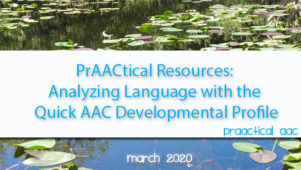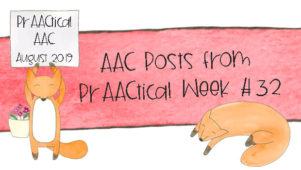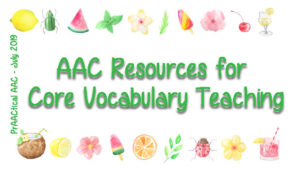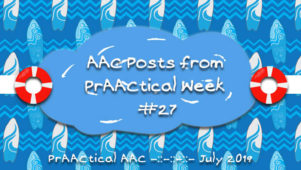How We Do It: Handy Tools for Language Sampling in AAC with Dr. Jill Senner and Matthew Baud
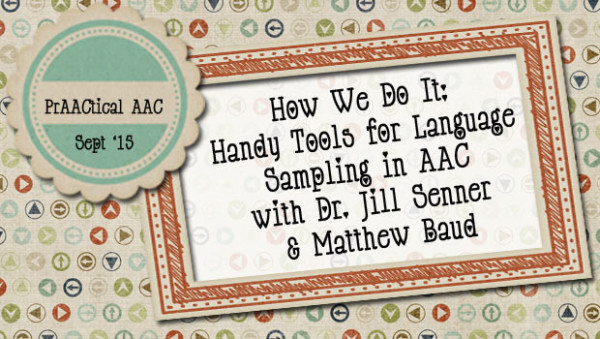
We are pleased to welcome back Dr. Jill Senner and Matthew Baud to talk about a topic near and dear to my heart: language sampling. Jill is an AAC SLP and the owner of Technology and Language Center. An experienced AAC interventionist, she has presented at numerous national conferences and has taught graduate AAC courses. You can follow Jill on Pinterest or visit her at the TALC Facebook page. Matthew (@Mbaud12/Twitter) is the AT Coordinator at Niles Township District for Special Education where he conducts AAC evaluations, trainings, and coaching of AAC. He has an AAC private practice and is an adjunct AAC instructor at Saint Xavier University. Matthew has presented at several national and state conferences. In this post, they share their favorite tips and resources for language sampling and language sample analysis.
::::::::::::::::::::::::::::::::::::::::::::::::::::::::::::::::::::::::::::::::::::::
Language sample analysis is an oldie but a goodie in the field of speech-language pathology. While writing down and analyzing what children say is not a new idea, modifying language sampling for children who use AAC is a more recent adaptation. Language sampling can be a valuable addition to the language assessment process for individuals using AAC.
Language sampling can provide rich information about expressive language use in children who use AAC (Van Tatenhove, 2014). Samples can be mined for a wealth of data about a child’s semantics, syntax, frequency of communication and more. The data obtained from language sampling can be used to assist in device selection, developing appropriate goals, and monitoring progress. There are a variety of tools available to help in the collection process:
- Chalk Talk – Augmentative Communication in the Classroom includes an Observation Procedure for collecting language samples in the classroom for individuals using AAC. It is available as a free download from Missouri Assistive Technology.
- Chapel Hill Snippets Language Sampling for Kindergarten Through Third Grade provides forms and instructions for collecting language samples from students in regular education classrooms. This is also a free download.
- We compiled the Tool for Analysis of Language and Communication (TALC) to collect utterances of individuals using AAC in their everyday activities. The tool provides ways to code each of the multiple modes of communication that a child might use. The setting, communication partners, and activities can all impact the mode, quantity, and types of utterances so the record form leaves spaces for all of the above to be noted. The tool provides summary information regarding modes of communication used and prompt levels in addition to more traditional language sampling data such as mean length of utterance (MLU) and type-token ratio. It is available as a free download from Technology and Language Center, Inc.
Many devices have built-in keystroke recording to help with the process. However, videotaping is still highly recommended because built-in logging does not record other modes of communication such as gesture and vocalization, nor does it discriminate between a key activated by the user versus one modeled by a partner. A number of language sample analysis tools are available to make interpretation faster and easier:
- Text Content Analysis Tool is a free online tool that generates a variety of text statistics including total word count and total unique words that can be used to calculate type token ratio.
- Computerized Language Analysis (CLAN) is free software designed specifically to analyze data transcribed in the CHAT format. This is the format used in the Child Language Data Exchange System (CHILDES) Project.
- Computerized Profiling is freeware designed to assist with language analysis.
- Systematic Analysis of Language Transcripts (SALT) software can calculate a variety of measures from collected language samples.
- Realize Language is a subscription service that can be used with PRC devices, Saltillo NOVAchat devices, and iPads with LAMP: Words For Life and TouchChat HD apps to analyze data logs collected by the devices.
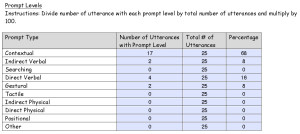
We hope these handy tools help you hammer home your next language assessment.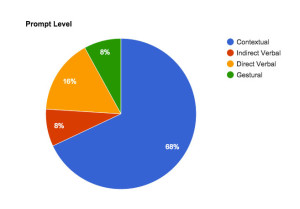
References
Van Tatenhove, G. (2014). Issues in language sample collection and analysis with children using AAC. Perspectives on Augmentative and Alternative Communication, 23, 65-74.
Filed under: PrAACtical Thinking
Tagged With: download, Jill Senner, language sample, language sample analysis, Matthew Baud, resources
This post was written by Carole Zangari

